You’ll discover that bringing Scandinavian-inspired plants into your home isn’t just about aesthetics – it’s about creating a minimalist sanctuary that breathes life into your space. These carefully chosen indoor plants complement the clean lines and natural elements that define Nordic design, while requiring minimal maintenance to thrive. Whether you’re redesigning your living room or adding subtle touches to your workspace, these fifteen plant varieties will transform your interior into a serene, Nordic-inspired retreat.
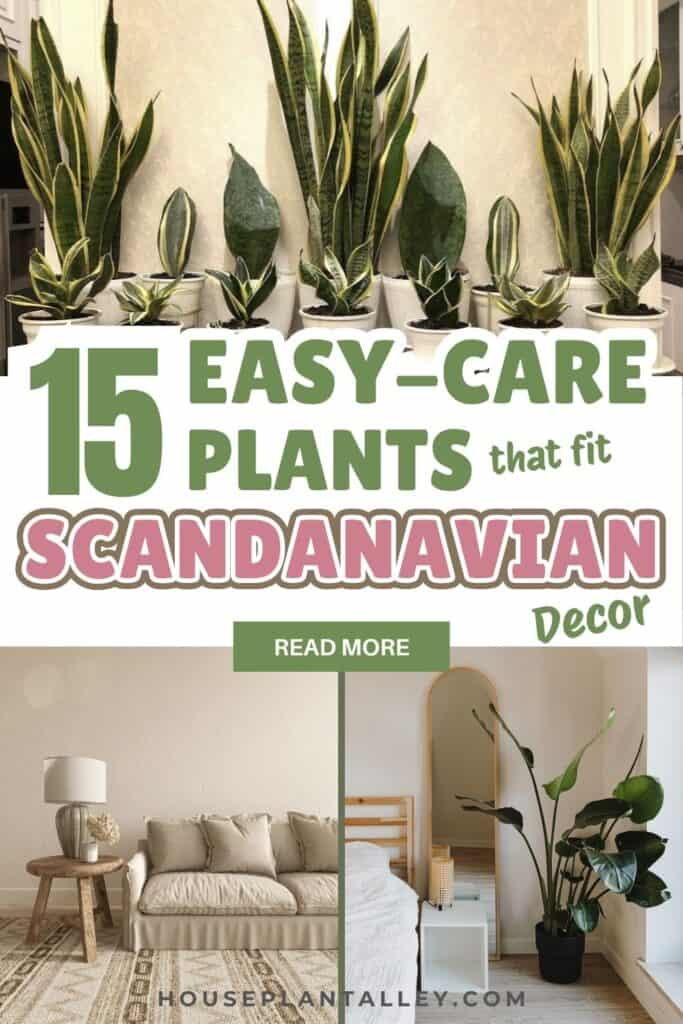
Contents
- 1 1. Snake Plant’s Sleek Leaves
- 2 2. ZZ Plant’s Glossy Fronds
- 3 3. Chinese Evergreen’s Muted Foliage
- 4 4. Rubber Plant’s Dark Leaves
- 5 5. Peace Lily’s White Blooms
- 6 6. Spider Plant’s Arching Stems
- 7 7. Janet Craig’s Deep Green
- 8 8. Philodendron’s Heart-Shaped Foliage
- 9 9. Cast Iron Plant’s Durability
- 10 10. Monstera’s Swiss Cheese Holes
- 11 11. Pothos’ Elegant Trailing Vines
- 12 12. Dracaena’s Upright Striped Stems
- 13 13. Fiddle Leaf’s Bold Shape
- 14 14. Bamboo Palm’s Graceful Stalks
- 15 15. Parlor Palm’s Feathery Fronds
1. Snake Plant’s Sleek Leaves
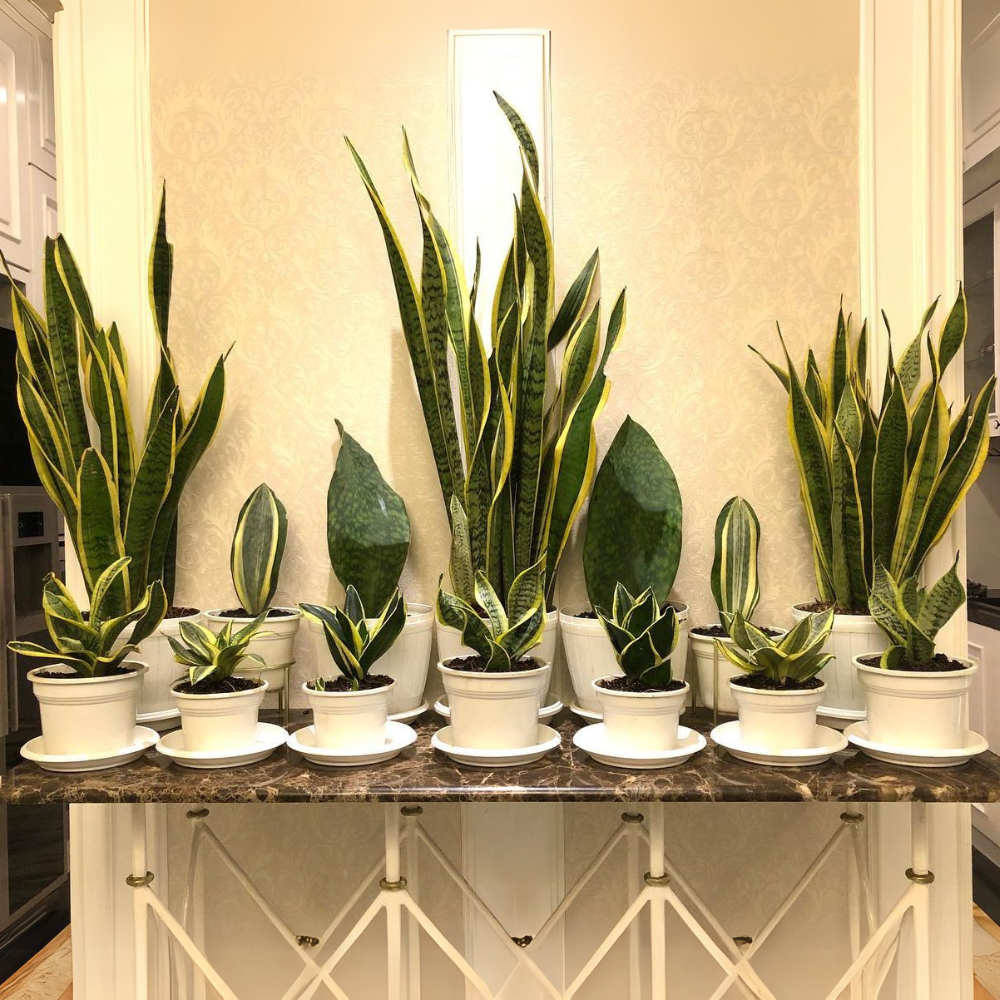
Snake plants (Sansevieria) feature tall, rigid leaves that grow vertically in an elegant, sword-like pattern. Their distinctive architectural form creates clean lines that complement modern spaces, while their variegated patterns of dark and light green stripes add subtle visual interest. The leaves’ smooth, glossy texture and upright growth habit make them particularly striking in minimalist settings.
- Light: Tolerates low light but thrives in bright indirect light; can handle some direct sun
- Water: Allow soil to dry completely between waterings; water sparingly in winter
- Soil: Well-draining potting mix; succeeds in sandy, loose soils
- Humidity: Adaptable to most indoor humidity levels
- Temperature: Prefers 70-90°F (21-32°C); can tolerate down to 50°F (10°C)
- Container: Choose pots with drainage holes; prefers to be slightly root-bound
- Fertilizer: Light feeding with balanced fertilizer during growing season
2. ZZ Plant’s Glossy Fronds
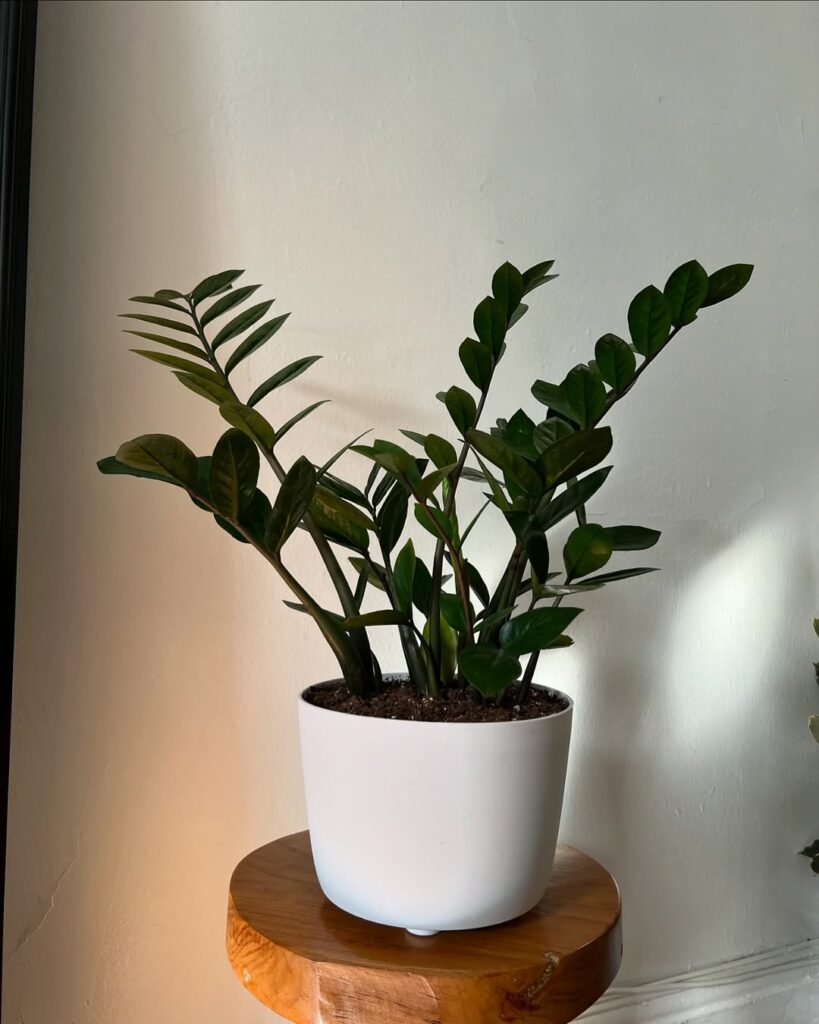
The ZZ Plant’s glossy fronds are one of its most striking features, consisting of thick, waxy leaflets arranged in a feather-like pattern along sturdy stems. These dark green, naturally polished leaves not only give the plant an elegant appearance but also serve a practical purpose by helping the plant conserve water and resist dust accumulation. The glossiness is due to a protective waxy coating that makes the fronds particularly resilient and contributes to the plant’s low-maintenance reputation.
- Light: Tolerates low to bright indirect light; avoid direct sunlight which can scorch leaves
- Water: Allow soil to dry completely between waterings; water every 2-3 weeks
- Soil: Well-draining potting mix with good aeration
- Humidity: Adaptable to normal indoor humidity levels
- Temperature: Thrives in 65-75°F (18-24°C)
- Fertilizer: Light feeding with balanced fertilizer every 4-6 months during growing season
- Pot Type: Container with drainage holes to prevent root rot
3. Chinese Evergreen’s Muted Foliage
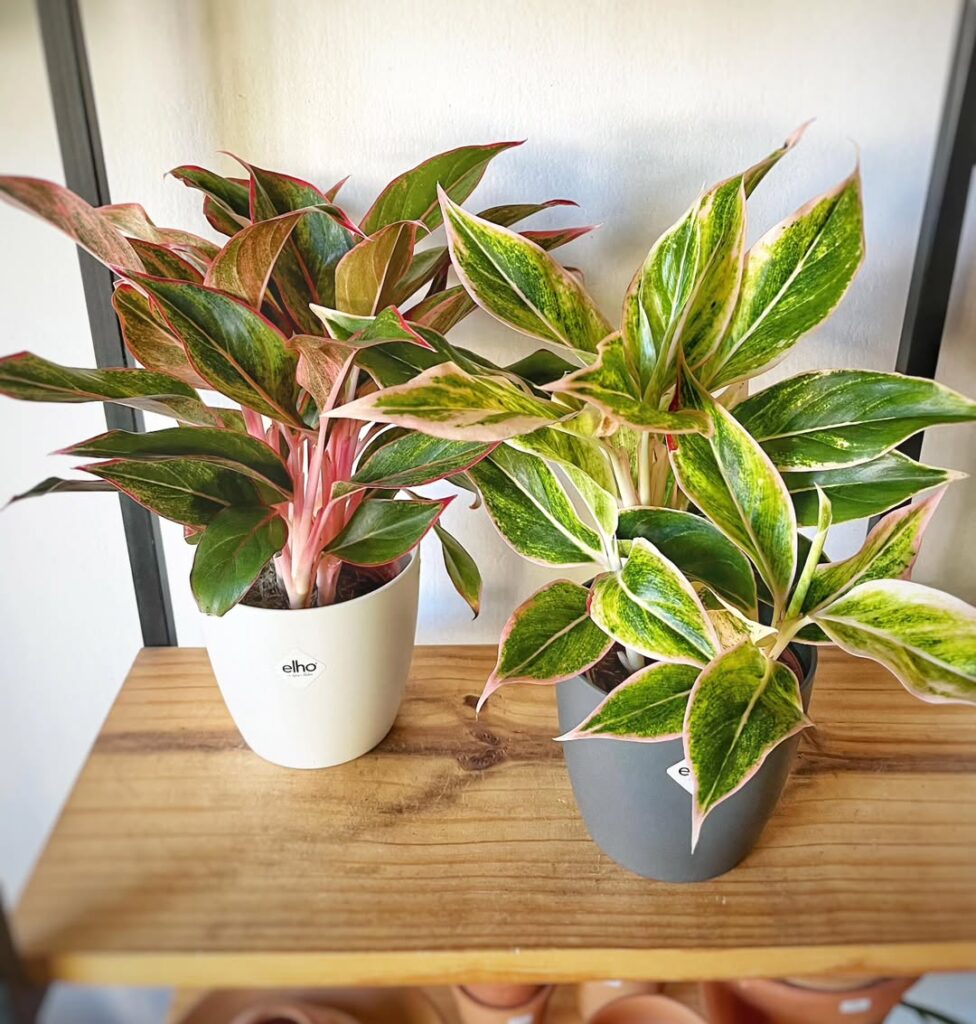
Chinese Evergreen (Aglaonema) features elegant, muted foliage with variegated patterns in silvery greens, creams, and occasional pink hues. The leaves are broad, oval-shaped, and grow in a compact, bushy formation that rarely exceeds three feet in height. Its subtle coloring and understated beauty make it an ideal choice for minimalist interior spaces, where it adds natural texture without overwhelming the aesthetic.
- Light: Tolerates low to medium indirect light; avoid direct sunlight which can burn leaves
- Water: Keep soil lightly moist but not waterlogged; water when top inch of soil feels dry
- Soil: Well-draining potting mix rich in organic matter
- Humidity: Thrives in moderate to high humidity; mist occasionally
- Temperature: Prefers warm conditions between 65-80°F (18-27°C)
- Fertilizer: Feed with balanced liquid fertilizer every 6-8 weeks during growing season
4. Rubber Plant’s Dark Leaves
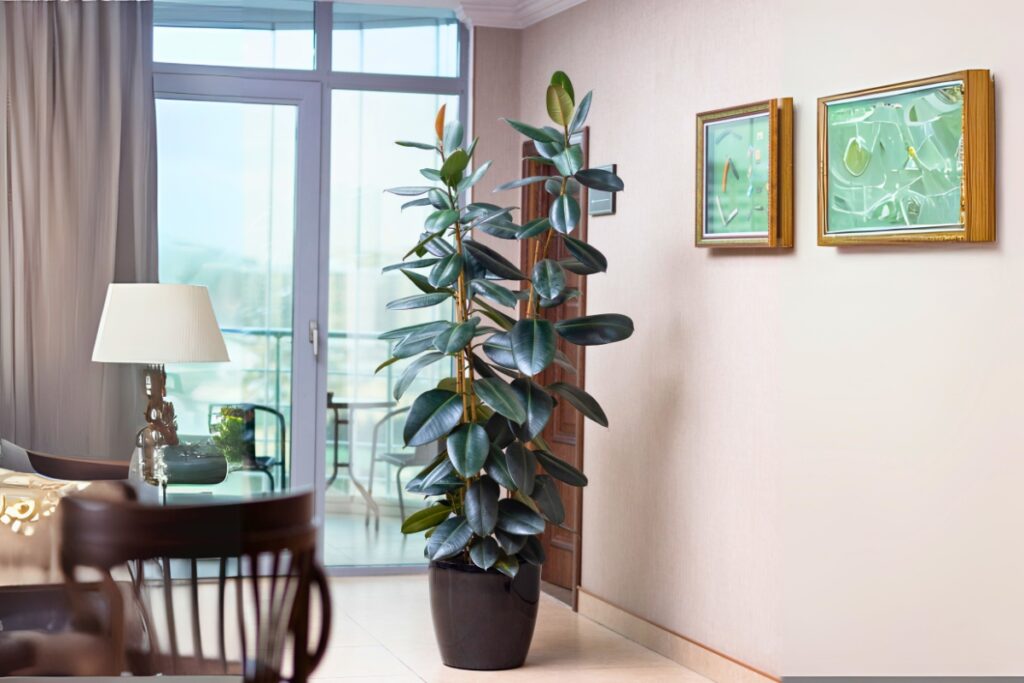
The Rubber Plant (Ficus elastica) features stunning dark, glossy leaves that add a bold statement to minimalist interior spaces. These broad, oval-shaped leaves can grow up to 12 inches long and display deep green to burgundy coloring, creating dramatic contrast against light walls. The plant’s thick, leathery foliage maintains its rich color throughout the year, making it an excellent choice for adding depth and visual interest to modern home décor.
- Light: Bright, indirect light; can tolerate moderate light but may lose lower leaves; protect from direct sunlight
- Water: Allow top 1-2 inches of soil to dry between waterings; reduce watering in winter
- Soil: Well-draining potting mix rich in organic matter
- Humidity: Moderate to high; mist leaves regularly or use a humidity tray
- Temperature: 60-75°F (15-24°C); avoid cold drafts
- Fertilizer: Feed monthly during growing season with balanced liquid fertilizer
- Growth: Clean leaves regularly to maintain glossy appearance and allow maximum light absorption
5. Peace Lily’s White Blooms
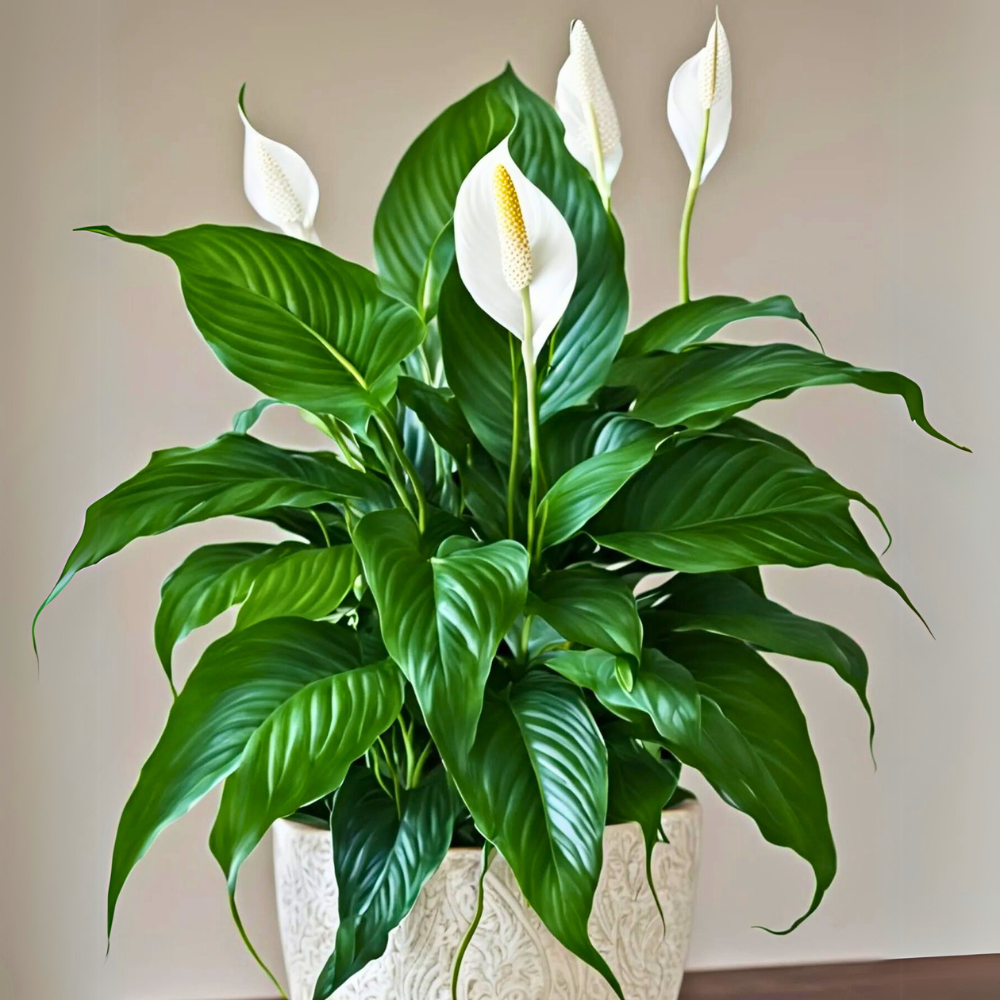
The Peace Lily produces elegant white blooms that rise above its dark green foliage like flags of surrender. These flowers, technically called spathes, are actually modified leaves that surround a spike of tiny true flowers. The pristine white blooms typically appear several times throughout the year, with the most prolific flowering occurring in spring, though indoor plants may bloom sporadically in response to ideal conditions. Each bloom can last for several weeks before gradually fading to green.
- Light: Bright indirect light; can tolerate low light but may not bloom as frequently
- Water: Keep soil consistently moist but not waterlogged; water when top inch of soil feels dry
- Soil: Well-draining potting mix rich in organic matter
- Humidity: Prefers high humidity (50-60%)
- Temperature: 65-80°F (18-27°C)
- Fertilizer: Feed monthly with balanced liquid fertilizer during growing season
- Container: Pot with drainage holes to prevent root rot
6. Spider Plant’s Arching Stems
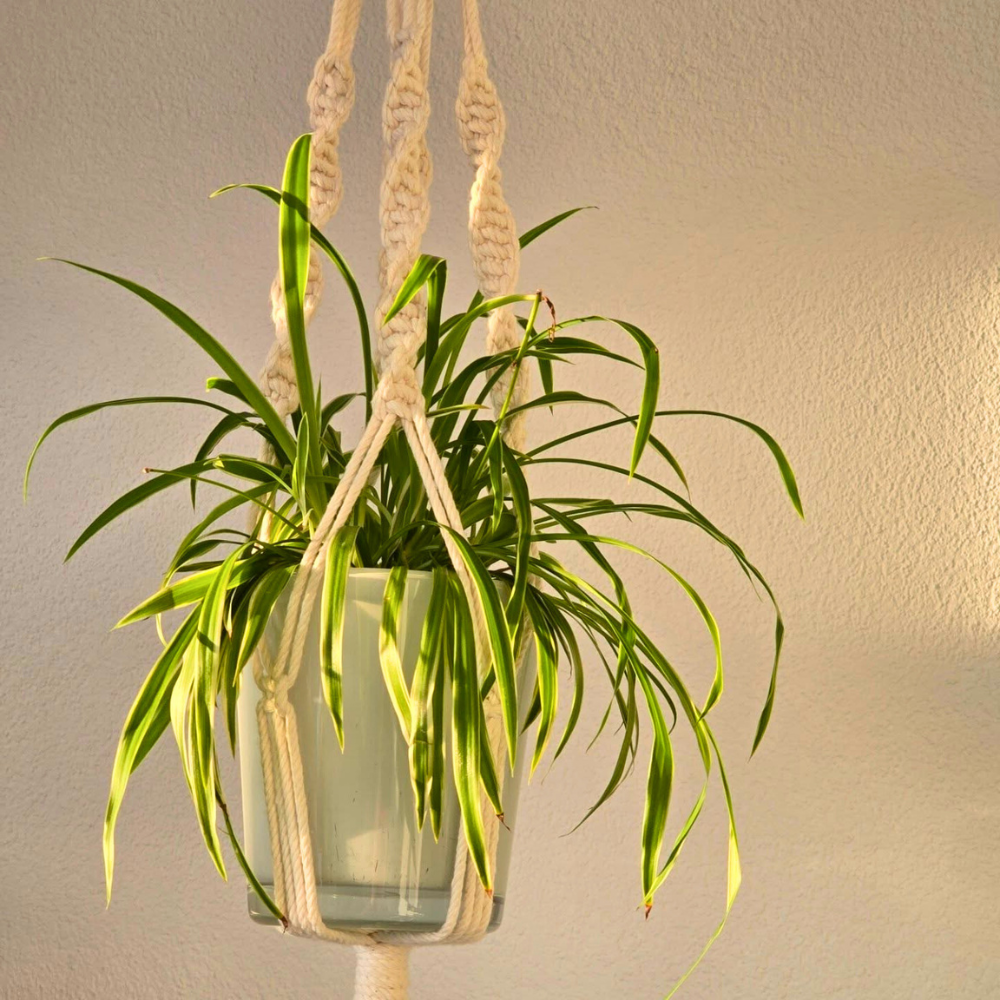
Spider plants feature distinctive arching stems, also known as stolons, that gracefully cascade over the sides of containers and hanging baskets. These slender stems grow outward from the parent plant and produce small plantlets, or “babies,” at their ends, creating an elegant cascade of foliage that resembles a green fountain. The plantlets can be left attached to create a dramatic trailing effect or removed to propagate new plants.
- Light: Bright indirect light; can tolerate lower light conditions but may lose variegation; avoid direct sunlight
- Water: Keep soil moderately moist; allow top inch to dry between waterings; sensitive to fluoride in tap water
- Soil: Well-draining potting mix rich in organic matter
- Humidity: Tolerates average indoor humidity levels
- Temperature: 60-75°F (15-24°C)
- Fertilizer: Light feeding with balanced fertilizer every 2-3 months during growing season
- Container: Well-draining pot with drainage holes; hanging baskets ideal for displaying trailing stems
7. Janet Craig’s Deep Green
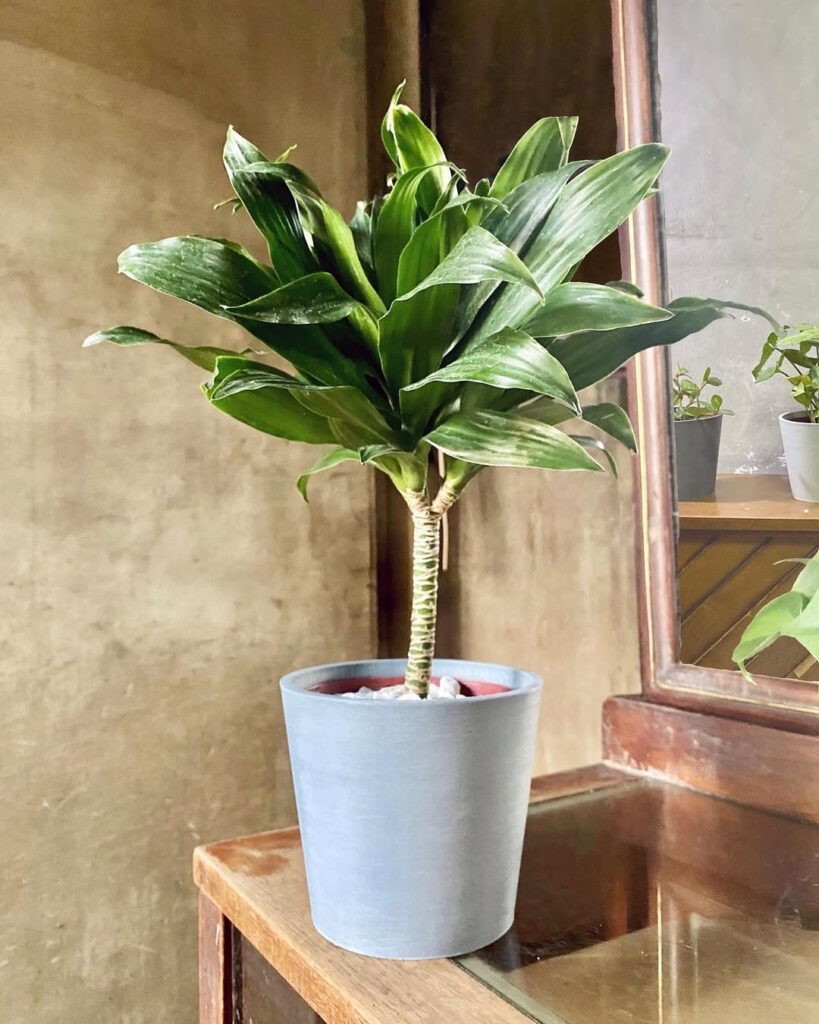
Janet Craig’s Deep Green (Dracaena deremensis ‘Janet Craig’) is a popular cultivar of the Dracaena family, known for its striking deep green, glossy leaves that grow in rosettes along sturdy canes. This elegant indoor plant features long, sword-like foliage that can reach up to 12 inches in length, creating a lush, tropical appearance. As a slow-growing plant that can reach heights of 10 feet or more in ideal conditions, Janet Craig’s Deep Green is highly valued for its air-purifying qualities and adaptability to indoor environments.
- Light: Thrives in medium to low indirect light; avoid direct sunlight which can scorch leaves
- Water: Keep soil consistently moist but not waterlogged; water when top 1-2 inches of soil feels dry
- Humidity: Tolerates average indoor humidity; benefits from occasional misting
- Temperature: Prefers 65-80°F (18-27°C); avoid cold drafts
- Soil: Well-draining potting mix rich in organic matter
- Fertilizer: Feed with balanced houseplant fertilizer every 2-3 months during growing season
- Pot Type: Container with drainage holes
- Toxicity: Mildly toxic to pets and humans if ingested
8. Philodendron’s Heart-Shaped Foliage
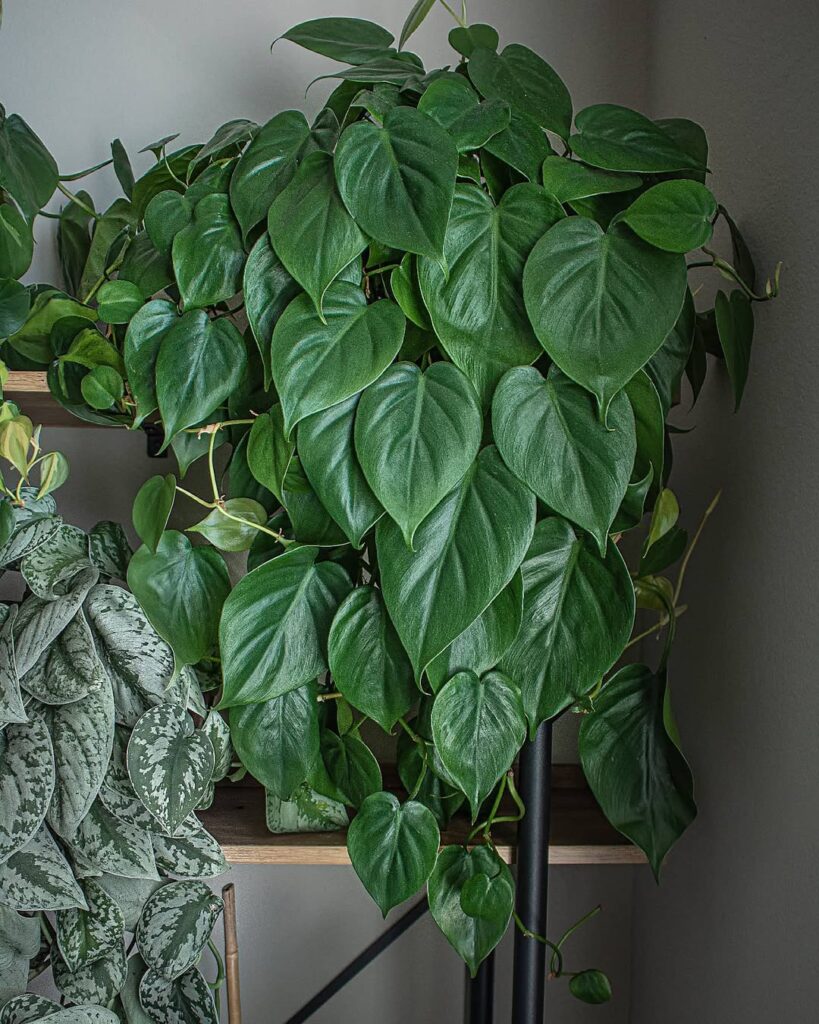
The Philodendron’s heart-shaped foliage is a defining characteristic that makes it a popular choice for minimalist indoor spaces. These glossy, deep green leaves grow in a perfect heart shape, creating an elegant and simple aesthetic that complements modern décor. The leaves emerge small and delicate, gradually expanding to their full size while maintaining their distinctive form, with some varieties featuring variegated patterns that add subtle visual interest without compromising their minimalist appeal.
- Light: Bright, indirect sunlight; can tolerate medium light conditions but avoid direct sun exposure
- Water: Allow top inch of soil to dry between waterings; water less in winter
- Soil: Well-draining, loose potting mix rich in organic matter
- Humidity: Prefers moderate to high humidity levels (50-60%)
- Temperature: Thrives in 65-80°F (18-27°C)
- Fertilizer: Monthly feeding during growing season with balanced liquid fertilizer
- Pot Requirements: Container with drainage holes; repot every 2-3 years
9. Cast Iron Plant’s Durability
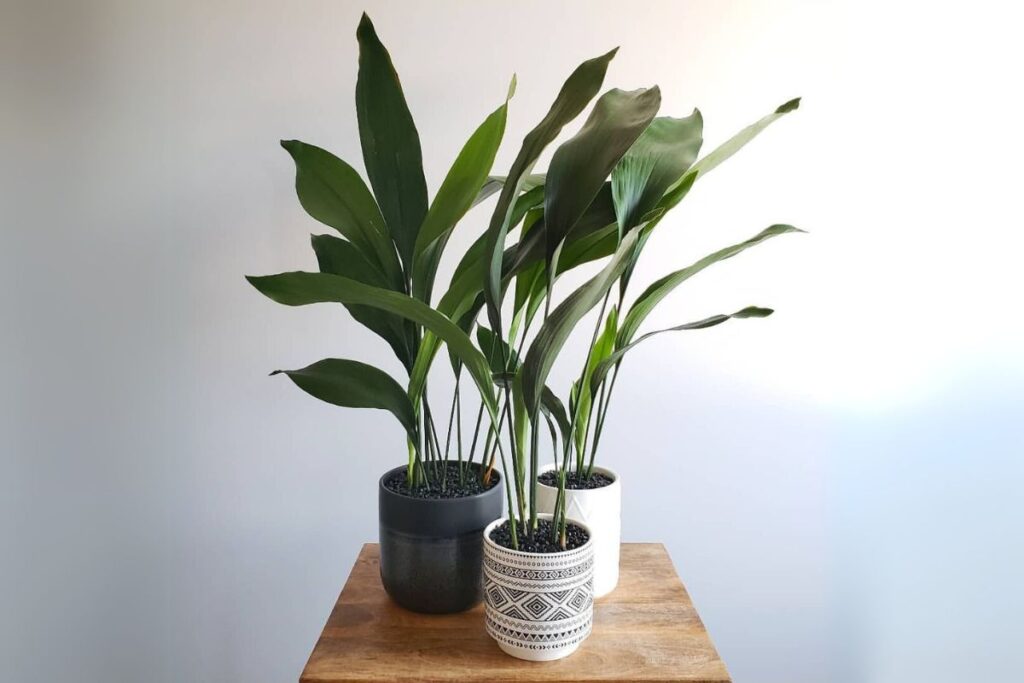
The Cast Iron Plant (Aspidistra elatior) lives up to its name with exceptional durability and resilience, making it one of the toughest indoor plants available. This slow-growing evergreen can withstand neglect, inconsistent watering, low light conditions, and temperature fluctuations that would kill most other houseplants. Its dark green, leathery leaves grow directly from the soil and can reach lengths of up to 2 feet, maintaining their attractive appearance even in challenging environments.
- Light: Tolerates deep shade to partial shade; avoid direct sunlight
- Water: Allow soil to dry between waterings; tolerates irregular watering
- Soil: Well-draining potting mix; tolerates various soil types
- Temperature: 45-85°F (7-29°C)
- Humidity: Adaptable to both low and average humidity levels
- Fertilizer: Light feeding 2-3 times per year during growing season
- Growth Rate: Very slow
- Soil pH: 5.5-6.5
10. Monstera’s Swiss Cheese Holes
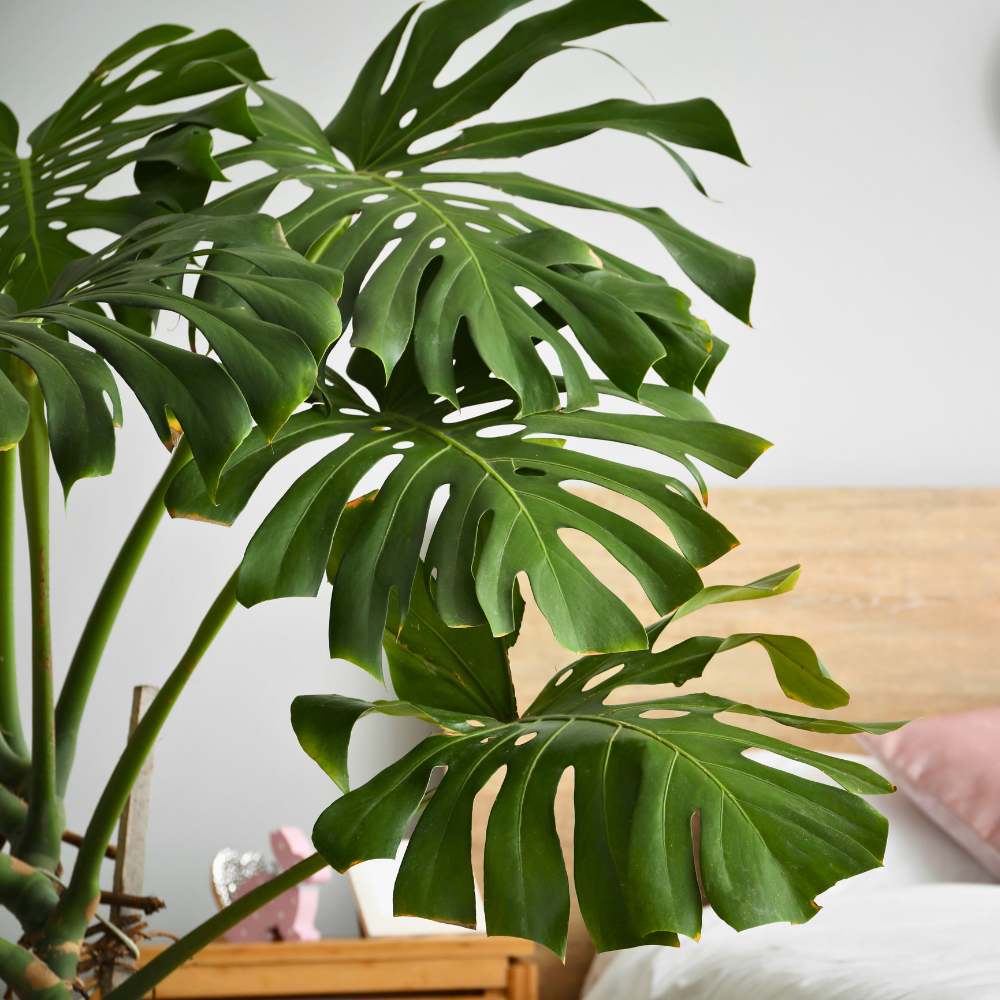
The distinctive holes and splits in Monstera deliciosa leaves, known as fenestrations, are a fascinating natural adaptation that serves multiple purposes. These Swiss cheese-like perforations allow sunlight to reach lower leaves in dense rainforest environments, help the plant withstand strong winds by reducing leaf resistance, and enable efficient water runoff during heavy tropical rains. Young Monstera leaves start without holes, but as the plant matures and receives proper care, new leaves develop increasingly dramatic fenestrations, creating the iconic tropical aesthetic that has made this plant a popular indoor specimen.
- Light: Bright, indirect sunlight; avoid direct sun which can burn leaves; some morning sun is tolerable
- Water: Allow top 2-3 inches of soil to dry between waterings; more frequent in growing season, less in winter
- Soil: Well-draining, rich potting mix with peat moss, perlite, and orchid bark
- Humidity: 60-80% humidity; benefits from regular misting or humidifier
- Temperature: 65-85°F (18-29°C); protect from cold drafts
- Support: Requires moss pole or trellis for climbing and proper development of fenestrations
- Fertilizer: Monthly feeding during growing season with balanced houseplant fertilizer
11. Pothos’ Elegant Trailing Vines
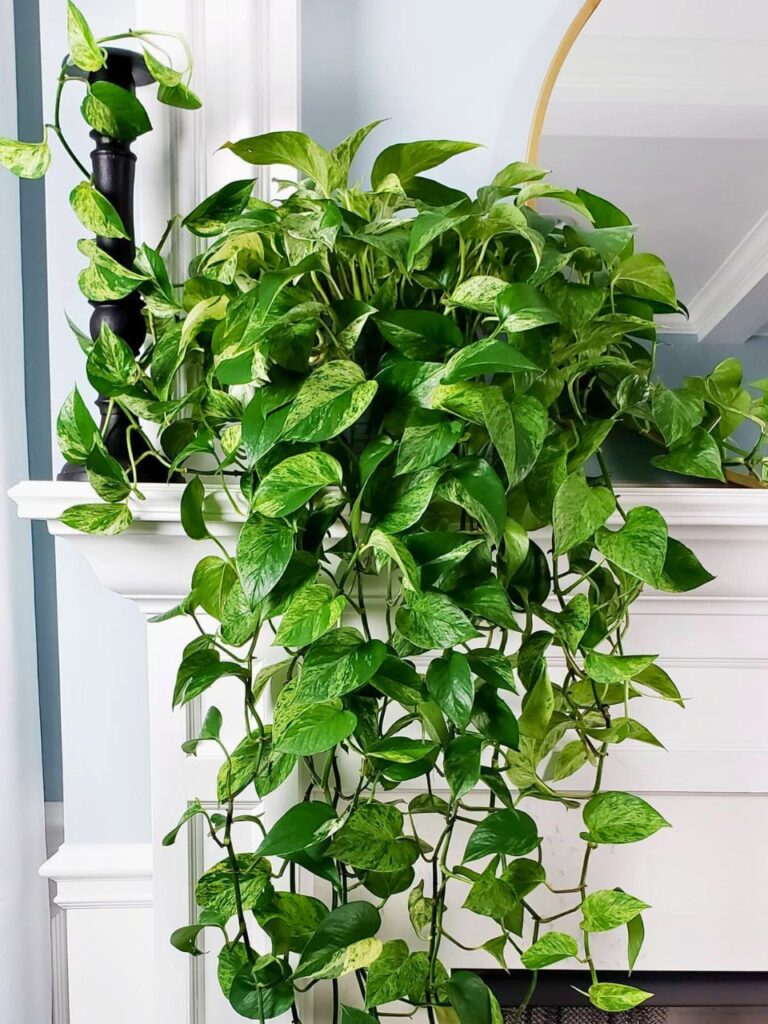
Pothos’ elegant trailing vines are a defining feature of this popular houseplant, creating graceful cascades of heart-shaped leaves that can transform any indoor space. These adaptable vines can grow several feet long, either hanging dramatically from elevated planters and shelves or climbing up supports with their aerial roots. The variegated foliage comes in various patterns of green, white, and yellow, adding visual interest as the vines extend and create natural living artwork.
- Light: Tolerates low to bright indirect light; avoid direct sunlight which can burn leaves
- Water: Allow top 1-2 inches of soil to dry between waterings; water less in winter
- Soil: Well-draining potting mix with good aeration
- Humidity: Adapts to average household humidity but thrives in higher humidity
- Temperature: Comfortable in normal room temperatures between 60-80°F (15-27°C)
- Container: Pot with drainage holes to prevent root rot
- Fertilizer: Monthly feeding with balanced houseplant fertilizer during growing season
12. Dracaena’s Upright Striped Stems
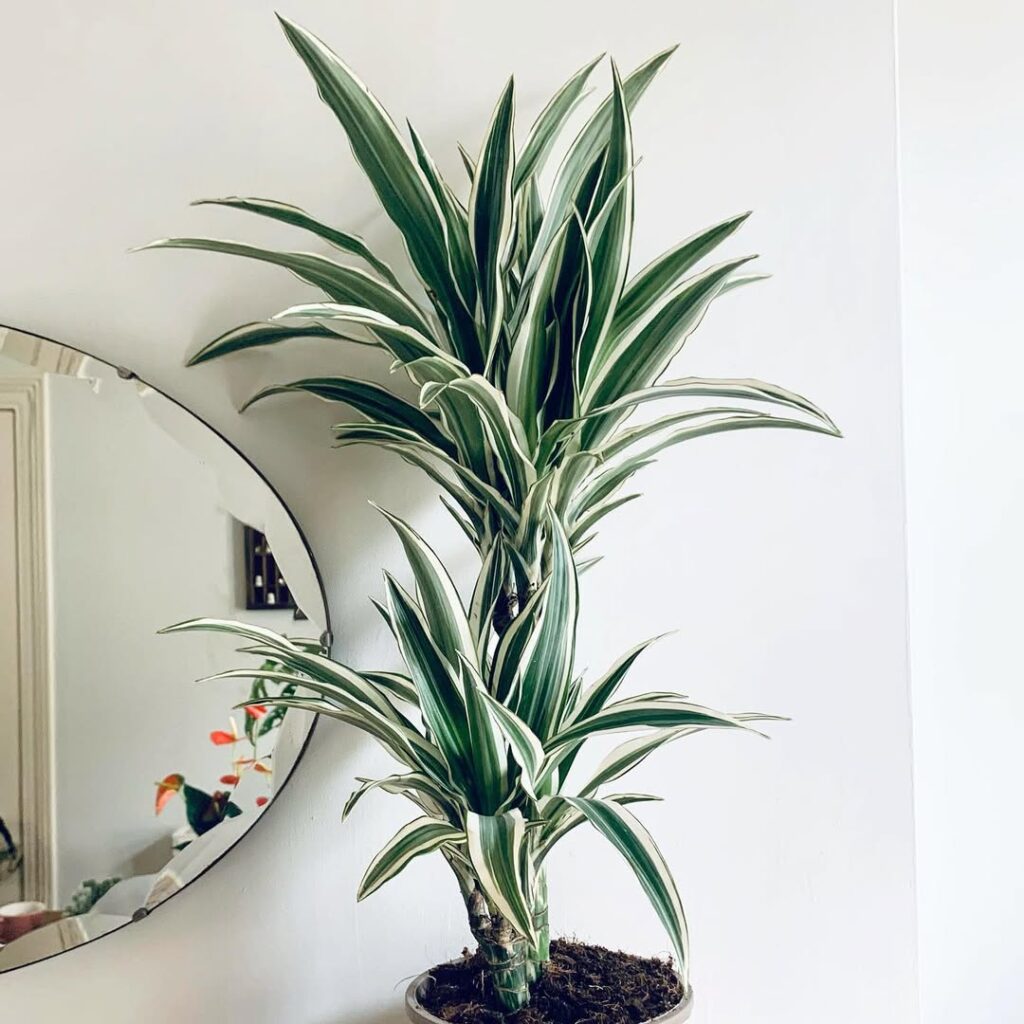
Dracaena’s upright striped stems create a striking architectural presence in any minimalist space. These distinctive stems can grow several feet tall and feature variegated patterns of green, cream, or red stripes running vertically along their length. As the plant matures, it sheds lower leaves, exposing more of the unique stem pattern while maintaining an elegant crown of sword-like foliage at the top, making it an excellent choice for adding height and visual interest to room corners or bare walls.
- Light: Bright indirect light; can tolerate moderate shade but may lose variegation; avoid direct sunlight
- Water: Allow top 1-2 inches of soil to dry between waterings; reduce watering in winter
- Soil: Well-draining potting mix with added perlite
- Humidity: Average room humidity (40-50%)
- Temperature: 65-80°F (18-27°C)
- Fertilizer: Light feeding with balanced fertilizer every 2-3 months during growing season
- Container: Pot with drainage holes; size according to root mass
13. Fiddle Leaf’s Bold Shape
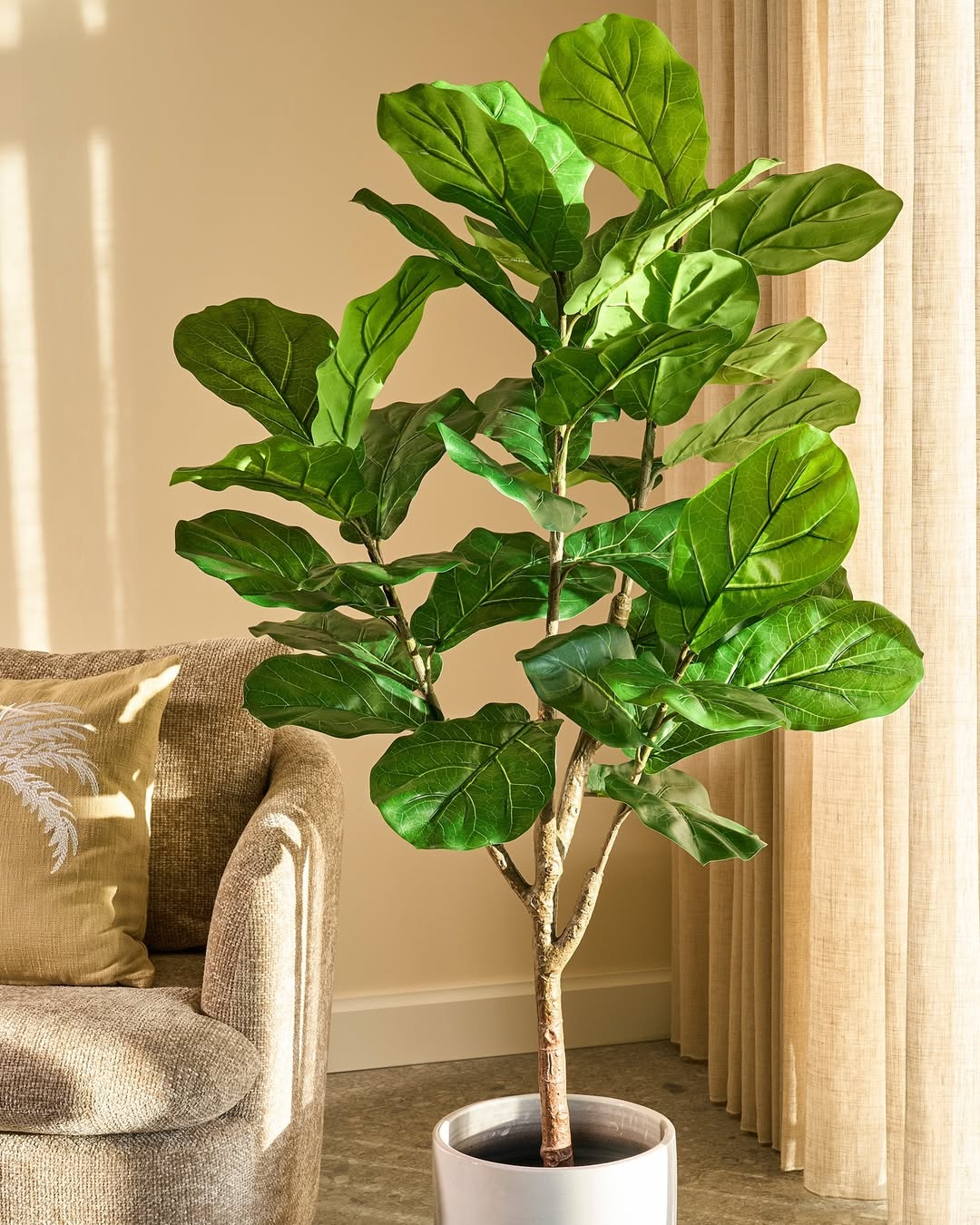
The Fiddle Leaf Fig (Ficus lyrata) makes a striking minimalist statement with its large, violin-shaped leaves that grow upright on a tall stem. Its bold architectural form creates dramatic visual impact while maintaining clean lines, making it a favorite choice for modern interior spaces. The dark green, glossy leaves can grow up to 12 inches long and cluster at the top of the plant, creating a sculptural silhouette that draws the eye upward.
- Light: Bright, indirect sunlight; can tolerate some direct morning sun but protect from harsh afternoon rays
- Water: Allow top 2 inches of soil to dry between waterings; reduce watering in winter
- Soil: Well-draining, rich potting mix with good aeration
- Humidity: Prefers 40-60% humidity; mist leaves or use a humidifier
- Temperature: 60-75°F (15-24°C)
- Fertilizer: Feed monthly during growing season with balanced liquid fertilizer
- Container: Plant in pot with drainage holes; repot every 2 years or when rootbound
14. Bamboo Palm’s Graceful Stalks
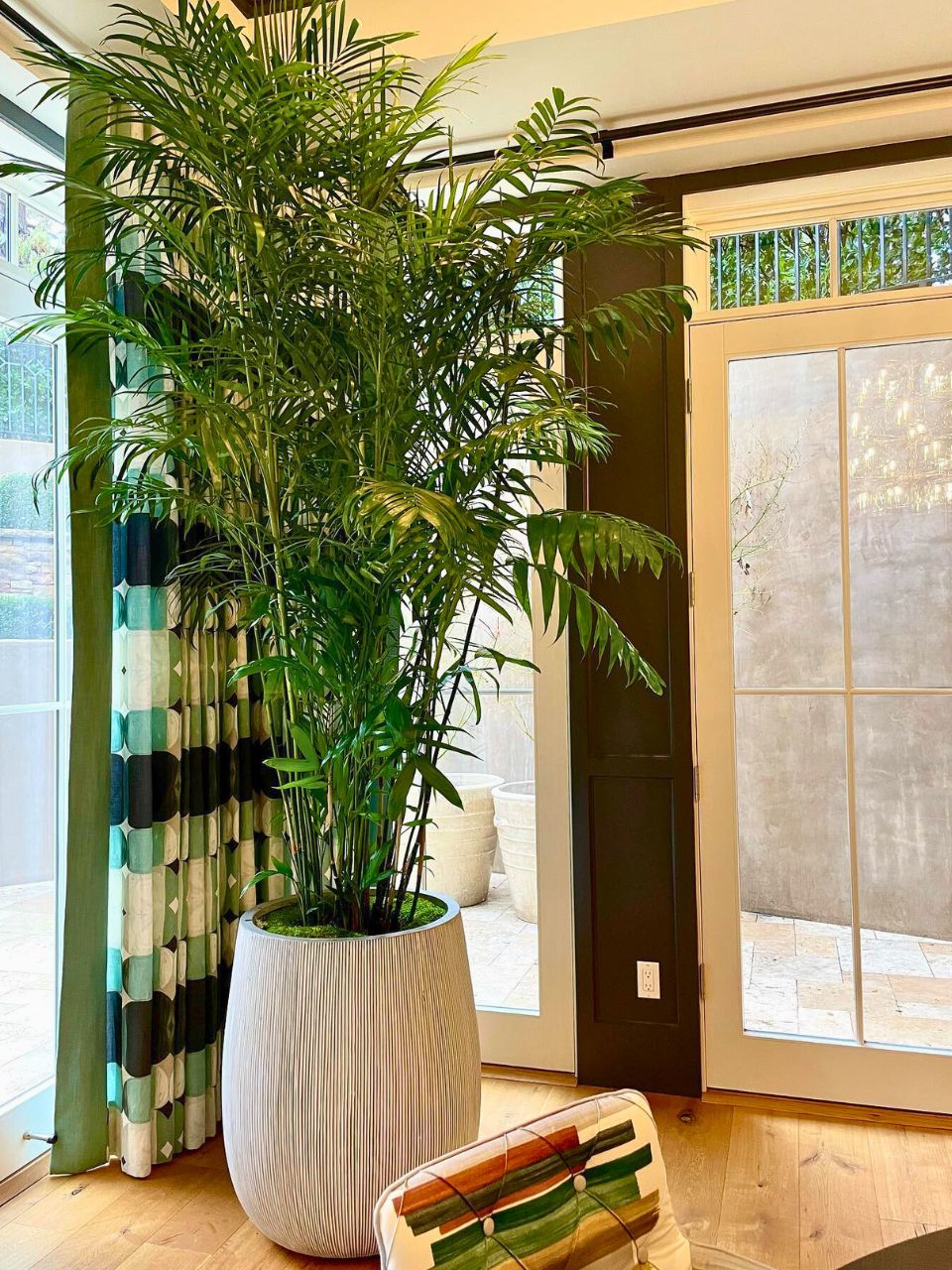
Bamboo palm adds an elegant vertical element to minimalist spaces with its distinctive jointed stems and delicate leaves. Whether grown as a single stalk or in a cluster, bamboo palm creates a zen-like atmosphere and requires minimal maintenance, making it an ideal choice for modern interiors.
- Light: Bright, indirect light; avoid direct sunlight which can burn leaves
- Water: If grown in water, change every 1-2 weeks; if in soil, keep consistently moist but not waterlogged
- Temperature: 65-95°F (18-35°C)
- Humidity: Moderate to high; mist occasionally
- Soil: Well-draining potting mix
- Container: Standard pots with drainage
- Fertilizer: Light feeding every 2-3 months with diluted liquid fertilizer
- Growing medium options: Clean pebbles and water, or well-draining potting soil
15. Parlor Palm’s Feathery Fronds
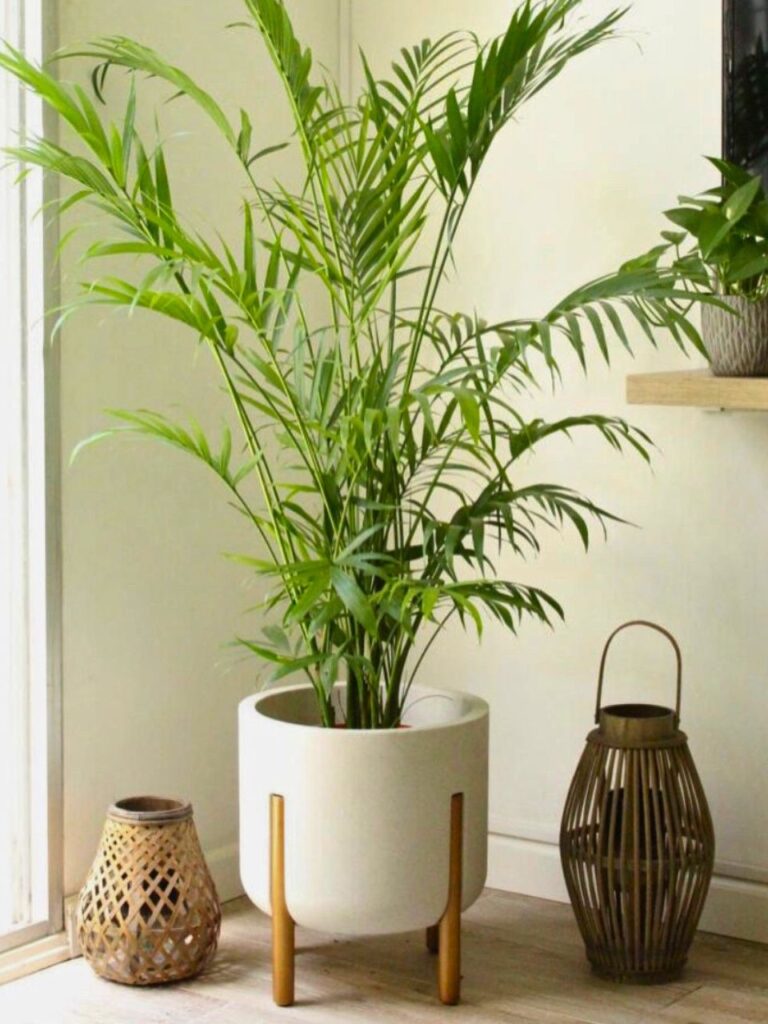
The Parlor Palm‘s feathery fronds are delicate, arching leaves that create an elegant tropical appearance. These slender, bright green fronds grow in a fountain-like pattern, reaching lengths of 12-18 inches on mature plants. The layered, fine-textured foliage consists of numerous small leaflets arranged along the stem, giving the plant its characteristic soft, airy appearance that adds graceful movement to indoor spaces.
- Light: Thrives in moderate to bright indirect light; tolerates low light conditions but may grow slower; avoid direct sunlight
- Water: Keep soil lightly moist but not soggy; water when top inch of soil feels dry
- Soil: Well-draining potting mix rich in organic matter
- Humidity: Prefers moderate to high humidity; tolerates average indoor humidity levels
- Temperature: Maintains best growth between 65-80°F (18-27°C)
- Fertilizer: Feed with balanced liquid fertilizer every 2-3 months during growing season
- Container: Choose pot with drainage holes to prevent root rot
